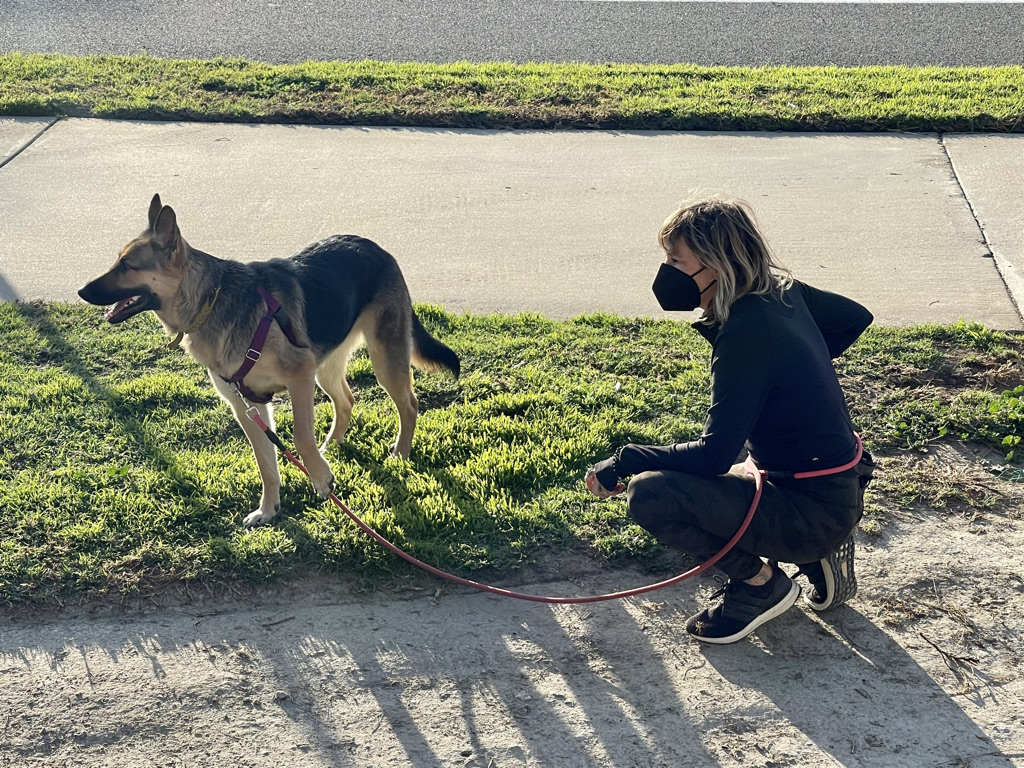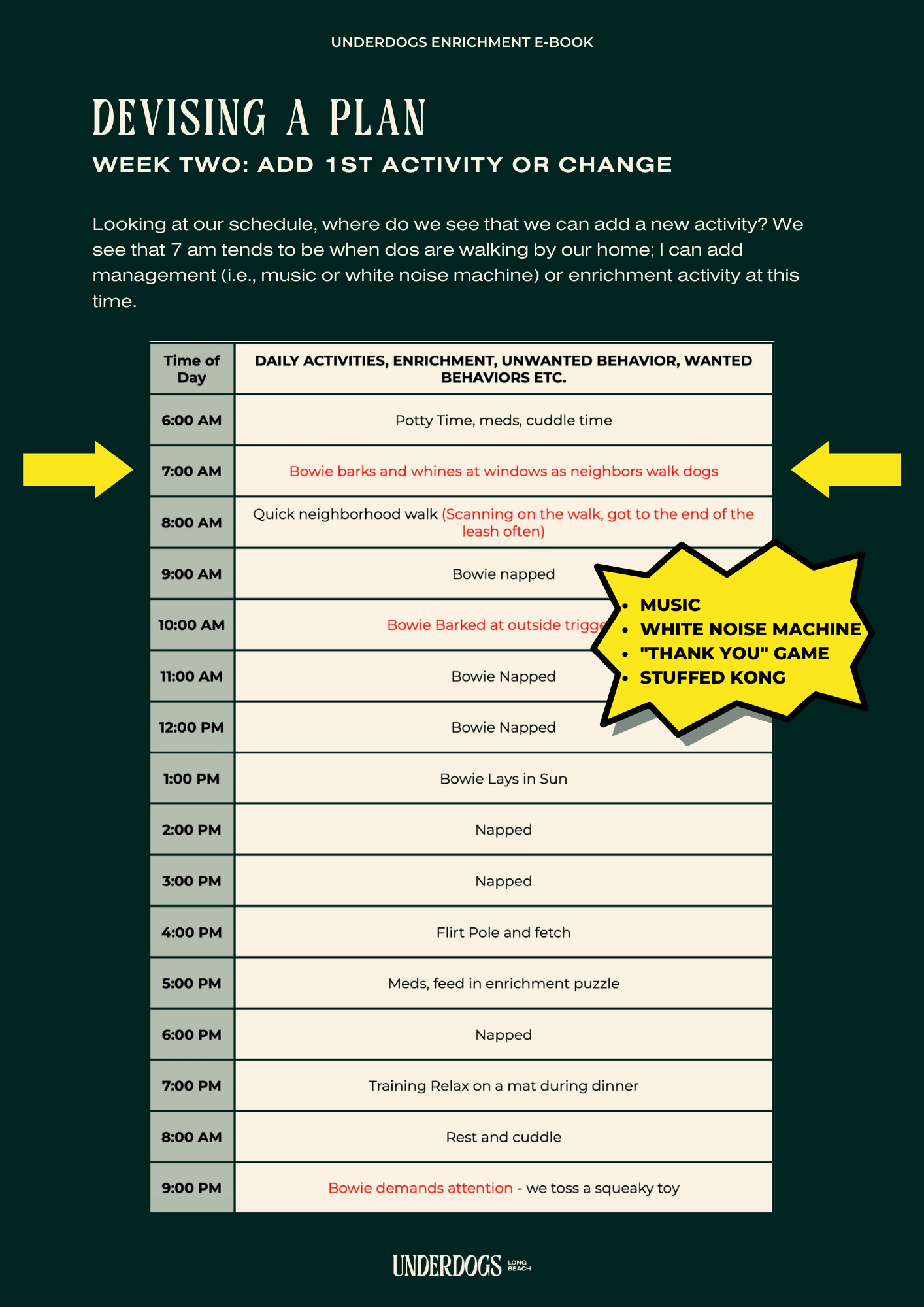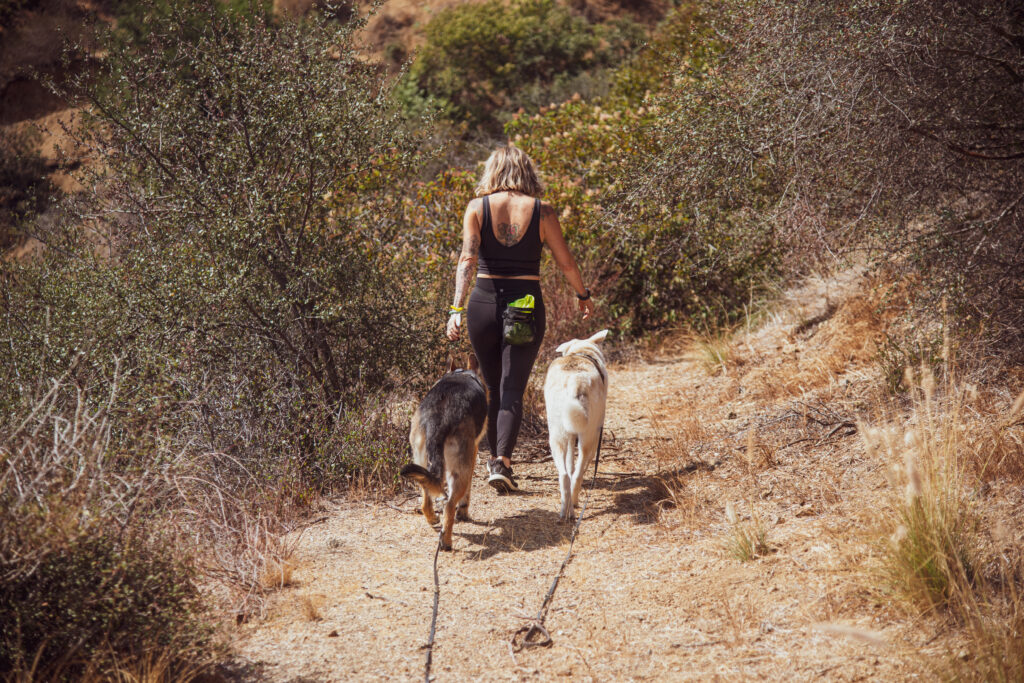How to build a Canine Enrichment plan

October 20, 2023
What is enrichment?
The term enrichment comes from the zoological world; enrichment meets animals’ needs to allow them to perform species-typical behaviors in healthy, safe, and appropriate ways.
Canine enrichment is a strategy to help meet our dog’s needs so that they are not prone to frustration, boredom, and stress. Meeting our dog’s needs often elevates much of our dog’s unwanted behaviors.
Enrichment is any activity your dog finds innately satisfying. In canines, a few examples include playing, chasing, scavenging, sniffing, fetching, digging, chewing, ripping, shredding, and dissecting. Providing dogs with plenty of constructive opportunities to engage in these natural behaviors will keep them mentally and physically stimulated and help meet their physical and psychological needs.
What are the benefits?
- Confidence Building
- Reduction of undesirable behaviors
- Alleviates stress and anxiety
- Assists in brain development and growth
- Allowing them to be dogs
- Alleviating depression
How do we test to see if your current enrichment is working?
Most clients are worried and overwhelmed with their dog’s behavior and doing everything they can to help their pets, so they can’t see what’s working and what’s not. I even need to zoom out on occasion and build a plan.
Data collecting is the way to information and an integral part of the enrichment plan; I know it sounds daunting! I swear it’s not; we break it down into small bite-size steps for the humans so that you successfully put together an enrichment plan.
The only way we can ensure that our dog’s activities are enriching to them is to have data written down with any daily changes. Don’t worry; you won’t do this forever, maybe 4-6 weeks, depending on the dog and the dog’s needs and behaviors.
For Example, If we walk our dogs three times a day for thirty minutes, train them for twenty minutes daily, and feed them their means in puzzles. They are destroying household items, dumpster diving (i.e., digging in the trash), and lunging and barking at dogs; we need to reassess our enrichment plan.
We suggest that all family members are involved in their dog’s enrichment, and this often means getting used to using worksheets, spreadsheets, or calendars to write down all of your dog’s behavior.
Defining our goals
- What unwanted behaviors do we see regularly?
- What desirable behaviors do we see regularly?
- What are our goal behaviors?
Below are worksheets from our Enrichment E-Book; you can check it out here.

EXAMPLE OF A CURRENT CLIENT WORKSHEET

Looking at our undesirable behaviors above, we can see clearly what behaviors we need to look at more closely. We also need to see which enrichment categories these behaviors fall into.
- Barking and growling at dogs and humans
- Fearful body language with new humans
- Fearful body language on walks with no triggers present
- Escape the front door to chase humans/dogs
- Barks and jumps on the door with the noise outside.
Categories of enrichment
Dogs are companion animals that were only domesticated 20,000 years ago. They have been domesticated and selected for specific jobs since the beginning; having genetic and breed-specific needs is part of their DNA. Meeting our dog’s needs with enrichment is an ethical and welfare choice.
- Veterinary Health, hygiene, and nutrition
- Safety
- Security
- Instinctual Behaviors
- Foraging
- Physical exercise
- Sensory stimulation
- Social interactions
- Mental stimulation
- Rest or Zen time
- Independence
- Environmental
Based on our dog’s behaviors, we’re looking at undesirable behaviors; we can see which category our dog’s behavior fits into.
In the case of the dog above, we’re looking at these enrichment categories:
- Safety – Escaping
- Security – Exposure to stressors inside and outside the home
- Instinctual – This is a working breed with the need to bark and herd
- Sensory – The need for sound barriers
- Mental and physical or no-brainers in most cases

Coming up with a plan
After establishing what enrichment categories the behaviors fall into, we can clearly see what we need to work on and devise a plan!
We suggest starting with one change weekly, but this is not always possible as our dogs could be dealing with a safety issue, and we may need to jump in with the big guns, like in the case above.
In the case above, we chose to go in right away with some management changes that would help her feel safe in the home and not be able to escape. We added a sound and visual blocker in the home to allow the dog the opportunity for the dog to feel safe in the home, as well as fixed the lock on the door that she had managed to escape previously.
In week one, we added three easy steps that let her feel more relaxed; we can now collect daily data in our group calendar to see how this changed her daily life. We will likely add or adjust our enrichment activities or management in the following weeks.
In this plan, we are looking for enrichment that works and can hit many needs, not 20 new steps to your day. This is a work smarter, not harder plan.
Below is another example of a team’s plan, week two.

Data tracking is the most critical part of our work to ensure that our dog’s behaviors are changing, we’re helping them, and their needs are being met.
Enrichment Activities
This is the most fun part; we often start with management after we get to choose from many fun activities to meet those enrichment needs. It’s up to our dogs what’s enriching for them; just like humans, we don’t all love to hike, and some don’t love to read; we choose what activity makes our lives more complete.
Below are some favorite activities that we often suggest.
DECOMPRESSION WALKS
Sarah Stremming first coined the term decompression walks; Sarah Stremming defines a decompression walk as “a walk where the dog is allowed freedom of movement in nature.” This can be done off-leash or on a long line with a back-clipping harness. It’s crucial to have long lead skills, or this can be dangerous, and if your dog is off-leash, you’ll want a 100% recall!

Exploration, hikes, and adventures
If you have areas where dogs can explore without being exposed to triggers, this is for you! Many city people with dogs that struggle with aggression, fear, and reactivity must be careful where they go, off-leash dogs, and overcrowded spots.

Nose work and Sniffing games
Here are a few of our favorites:
- Find it
- Hide and Seek –
- Puzzles and DIY projects
Training
One of the many ways we can meet our dog’s enrichment needs is clicker training, shaping & capturing! This can meet their mental, instinctual, social, environmental, physical, safety, and sensory! Teaching dogs using positive reinforcement is confidence-building and gives them choices in activities.
Some other areas of enrichment that we love are:
- Play
- Destruction Boxes
- Puzzles
- Dog sports
- Social activities and more!
If you are interested in the step-by-step process, with handouts and worksheets, Check out our 75-page Enrichment E-Book that will help you strategize a plan to meet your dog’s needs and enrich their lives.
Leave a Reply Cancel reply
Underdogs Long Beach uses force-free dog training methods to build relationships between dogs and owners.
© Underdogs long beach | Legal